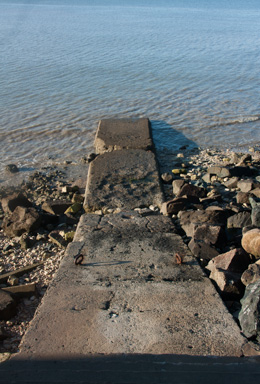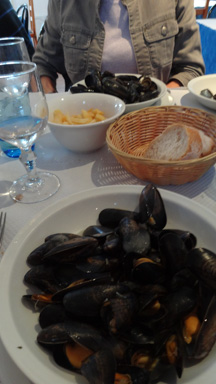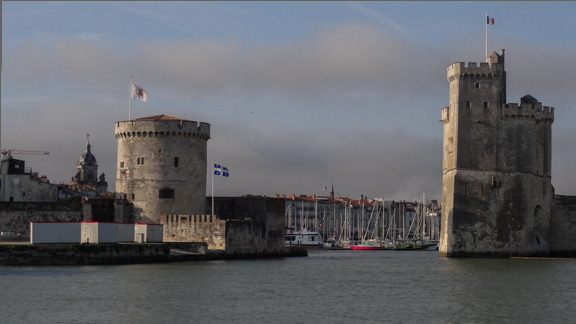La Rochelle – Introduction
We went to the seaside town of La Rochelle this weekend, to celebrate our anniversary, and because we have wanted to see La Rochelle for some time. The city has an amazing history, and it features in a number of the stories of our favorite detective, Chief Superintendent Maigret of the Paris Police Judiciary. In the understatement of the trip so far, we can say that La Rochelle did not disappoint.
We decided to stay at the Hotel Les Brises. This recommendation came from Ina Caro, the author of two of the best books on traveling in France, “Road from History,” and “Paris to the Past.” (If you’re planning a trip to Paris or France, you pretty much must read these books.) Les Brises is about a 25 minute walk along a seaside promenade into La Rochelle proper, and there are few more enjoyable walks in the world.
Our room at Les Brises was, well, sublime. The view was not bad…
Hard to beat that view; we spent a lot of time sitting on that terrace and watching the world – and hundreds of boats of every description – go by.
La Rochelle is a most interesting place, with an amazing history. I’ll divide La Rochelle comments into a couple sections, so you won’t have to read them all at once. The first will be on La Rochelle’s history.
History of La Rochelle
La Rochelle is an old, old city; there are records of Eleanor of Acquitaine giving it, in 1199, a charter upholding its rights as a free port, rights first received in 1137 from Eleanor’s father. This right of being independent was the pivot point of La Rochelle’s long history as a battleground between France and England. When Eleanor of Acquitaine divorced the French king Louis VII and married Henry, Duke of Normandy, she controlled nearly a third of present-day France, and when Henry became Henry II, King of England, all those lands in France became English territory. Not a good thing for peace between the two countries, and the cause of the Hundred Years War, during which La Rochelle yo-yo’ed between France and England, depending on who had the upper hand at the moment. However, in all the turmoil, La Rochelle, heavily fortified, was never conquered.
The reason for that is largely its location: on a peninsula with an excellent port. The land approaches to the city were well-fortified and easily defended. The port, its lifeline when the city was attacked by land, kept the city supplied with food and weaponry. Two towers were build to protect the port. The two towers stood on either side of the entrance to the port and still stand today:
The left tower is the Chain Tower. For hundreds of years, every night a huge chain was strung from it across the harbor to prevent ships from slipping in at night.
This worked until the early 1600’s; then things changed.
La Rochelle, in its independence, had long been a Protestant city in a Catholic country. Though the city had a legal right to be Protestant, a right guaranteed by kings for centuries, in the 1620s Cardinal Richelieu, Louis XIII’s main minister, decided to bring La Rochelle to heel; religious tolerance was not his strong point. Since then city had never fallen to an army, Richelieu decided to starve it into submission, gathered an army and in 1627, laid seige to the city. Among the soldiers in that seige army: Artos, Portos, Aramis and D’Artagnan – the Three Musketeers and their friend, the protagonist of Dumas’ Three Musketeer books.
La Rochelle wasn’t worried – the English had promised they would lift the siege and, until they could, they would supply the city with food using ships to bring it in. Then two turning points: in England, the Duke of Buckingham, who had suffered a humiliating defeat when he made a half-hearted attempt to break the seige, was assassinated by a Puritan fanatic the night before his much-reinforced fleet sailed, and the assault was canceled; and Richelieu had a dike built across the mouth of the port: no ship of any kind could enter. Fourteen months later, La Rochelle surrendered, its population of 28,000 starved to fewer than 5,000 survivors.
Next to our hotel were these three concrete slabs:
 These are said to be the only remaining pieces of Richelieu’s dike: they have been here since 1627! Personally, I’m skeptical. The builders of the dike would have used stone and these are concrete, and not very good concrete. I doubt they would have lasted four hundred years. Having said that, it is indeed the location of the dike, and the bar visible at low tide would be the rock laid down for the base of the dike.
These are said to be the only remaining pieces of Richelieu’s dike: they have been here since 1627! Personally, I’m skeptical. The builders of the dike would have used stone and these are concrete, and not very good concrete. I doubt they would have lasted four hundred years. Having said that, it is indeed the location of the dike, and the bar visible at low tide would be the rock laid down for the base of the dike.
La Rochelle: Friday
We arrived in la Rochelle about 4 o’clock Friday afternoon after a longer than expected drive. First delay was me relying on a French highway website that plotted our route and took us a long way round to the autoroute. Second was about 45 minutes of crawling down the autoroute, caused by two big trucks that tangled somehow; they were by the side of the road, with their trailers completely torn apart.
We drove through downtown La Rochelle to our hotel. Downtown was completely enveloped in smoke. Turns out the Hotel de Ville (not a hotel in our sense of the word, but a major city building), was burning. The Hotel de Ville has been there since 1298, and will surely be restored again – it has had more than one fire in that history.
After a “toes-up,” as the British say, we sat on our little terrace for a glass or two of wine, and then walked into the city. We had read of a excellent seafood restaurant, but our Rough Guide map of the old city showed the location off the map. We didn’t know how far off the map so we headed through town. Turned out, it was a long way off the map.
After about an hour and a half of very enjoyable strolling, we found the restaurant, Marie Galante. Small and informal, they were able to seat us. Though they had a nice menu, we had one thing on our minds: moule frites (mussles and fries). There they were on the menu and soon – voila! – there they were in front of us:

The restaurant was a delight. The walk back, at a slow pace, wasn’t so much. We arrived at the hotel after 11 p.m. When we told the desk clerk the next day where we had walked, she got an amazed look on her face and said, “Eight or ten kilometers!” That would be 5-6 miles. Yes, our feet confirmed that. Worth it for those moules.
La Rochelle Saturday
Cooler. Wetter. Really low clouds. After an excellent breakfast, we walked into and through town. Someone not too long ago realized that La Rochelle has a great asset in its waterfront, so all of our 25-minute walk into town is along a beautifully developed park and waterfront promenade:
La Rochelle is, as mentioned, an ancient town. It differs from many other places of similar age in that it seems to have been preserved rather than restored at some point. It has blocks and blocks of buildings with arcaded first floors holding shops and stores of all sorts, and apartments above them. If you removed the cars and changed the shops to what they once were, you’d see La Rochelle as it has been for six hundred years. It is an amazing experience, honestly.
That night we celebrated our anniversary at the restaurant Le Thiers du Temps. It was just great: a small place, holding only twenty people; food was sublime; the woman serving spoke some English and we spoke some French and she was delightful. Food? No way to describe it. Oysters for entrée, monkfish and risotto for main course, a chocolate conconction for Laurie’s dessert and for me? A mousse of fourme d’ambert (a blue cheese), with whipped cream and a couple tiny and powerful cherries. Yes, it was unusual but I’ve become a fan of fourme d’ambert cheese so I had to try it, and I’m glad I did.
La Rochelle Sunday
Sunday was a slow day; we did almost nothing even though the weather had turned perfect. We watched the boats sail out of the harbor, I walked into town to take a couple more pictures, and Laurie got to dip her toes in the Atlantic, standing on Richelieu’s dike.
A couple other miscellaneous pictures:
Well, I didn’t mean to drag on so long, really. We loved La Rochelle and are already trying to figure out when we can return.
Update: we made reservations to return to La Rochelle for Laurie’s birthday in early September.


Sorry to talk shop – news flash – we now allow sleeping in our libraries
Did the library get its new name: King County Flop House?
Not yet – I can’t wait until we allow bathing as well
La Rochelle sounds so fantastic – i think Steve and I should plan a trip there SOON.
La Rochelle went straight into the top tier on our “Favorite Cities of the World” list. A large part of this enamoration is surely because Laurie and I always like places on the water – rivers, lakes, oceans, whatever – and it’s hard to be away from the water in La Rochelle. Another big thing was the “preserved, not restored” aspect I mentioned in the post. The place has lots of restaurants and cafés around the old harbor, but it has the feeling that they’ve been there as long as La Rochelle has been there. And away from the harbor the buildings look much as they must have 500 years ago.
We’ve already booked the hotel for a return trip in September, and we didn’t even plan to go to La Rochelle until after we arrived in France.
Pingback: La Rochelle – again | Zumstegs on the Go